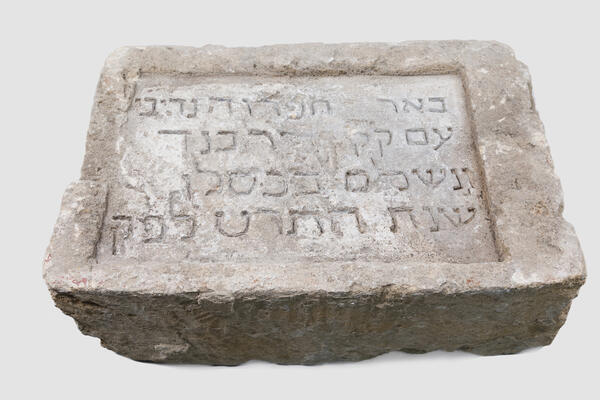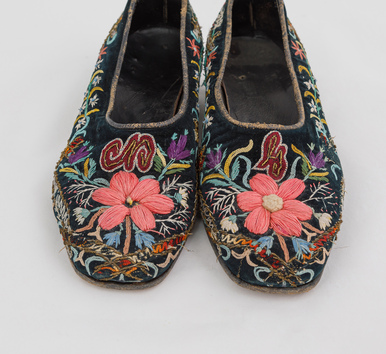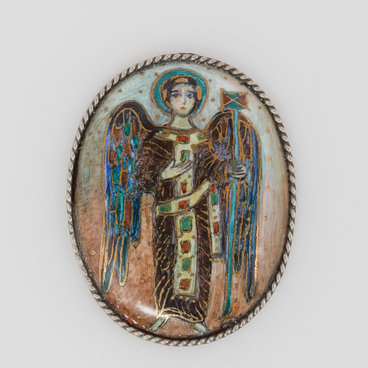The stone slab was found during the reconstruction of the old Derbent Kele-Numaz synagogue. There is an inscription on the slab carved in ancient Aramaic, which was translated by the Russian orientalist Evgeny Borisovich Rashkovsky. The text says that at the end of the 19th century, the Derbent community of mountain Jews dug a well for the inhabitants of the town. The slab is made of shell rock, which has a porous structure and a warm yellow hue. It is particularly durable and resistant to sharp weather changes, freezing temperatures and atmospheric phenomena.
The slab was kept in the old Kele-Numaz synagogue to commemorate the active participation of Jews in the development of the city. At the beginning of the 20th century there were seven synagogues and prayer halls in Derbent, and the Jewish community of the city accounted for about 15% of the population. Most of the money for the construction of the new synagogue was donated by the Hanukaev family — five merchant brothers. The synagogue with the area of more than 500 square meters was built in nine months and completed in 1914. Kele-Numaz became the center of religious life for the Jews of Derbent.
The word “synagogue” translates as “school” and “assembly”. Historically it is the main spiritual center of the Jewish community. The first synagogues appeared 25 centuries ago in Babylon after the destruction of Solomon’s Temple. Synagogues were built based on the model of the Tabernacle, the movable temple that the Jews erected in the desert during the Exodus from Egypt.
By 2009, the Kele-Numaz synagogue had fallen into disrepair and was damaged by a grenade thrown by intruders, but continued to function. Local members of the Jewish community and Jews from different countries took part in fundraising for the reconstruction. The synagogue building was dismantled and rebuilt with old stones and new materials.
Today, the Kele-Numaz hosts daily prayers, Torah lessons for men, women’s and men’s mikvahs (pools), a restaurant, a kindergarten, and a Sunday school. The synagogue has a Museum of the History and Culture of Mountain Jews, offices for the rabbi, guest rooms, and a sukkah (hut) in the courtyard. The total area of the Jewish Community Center is over two thousand square meters — it is the largest synagogue in the North Caucasus.
The slab was kept in the old Kele-Numaz synagogue to commemorate the active participation of Jews in the development of the city. At the beginning of the 20th century there were seven synagogues and prayer halls in Derbent, and the Jewish community of the city accounted for about 15% of the population. Most of the money for the construction of the new synagogue was donated by the Hanukaev family — five merchant brothers. The synagogue with the area of more than 500 square meters was built in nine months and completed in 1914. Kele-Numaz became the center of religious life for the Jews of Derbent.
The word “synagogue” translates as “school” and “assembly”. Historically it is the main spiritual center of the Jewish community. The first synagogues appeared 25 centuries ago in Babylon after the destruction of Solomon’s Temple. Synagogues were built based on the model of the Tabernacle, the movable temple that the Jews erected in the desert during the Exodus from Egypt.
By 2009, the Kele-Numaz synagogue had fallen into disrepair and was damaged by a grenade thrown by intruders, but continued to function. Local members of the Jewish community and Jews from different countries took part in fundraising for the reconstruction. The synagogue building was dismantled and rebuilt with old stones and new materials.
Today, the Kele-Numaz hosts daily prayers, Torah lessons for men, women’s and men’s mikvahs (pools), a restaurant, a kindergarten, and a Sunday school. The synagogue has a Museum of the History and Culture of Mountain Jews, offices for the rabbi, guest rooms, and a sukkah (hut) in the courtyard. The total area of the Jewish Community Center is over two thousand square meters — it is the largest synagogue in the North Caucasus.




